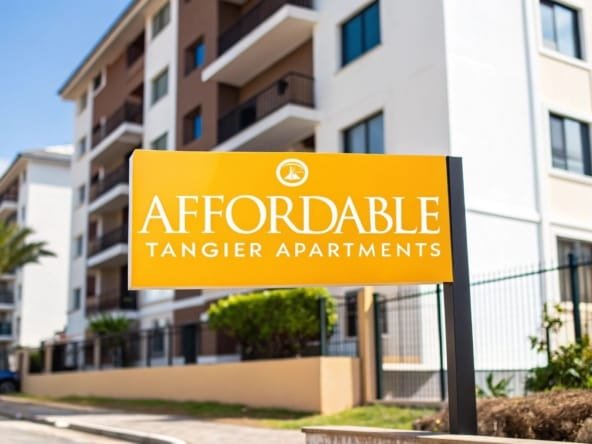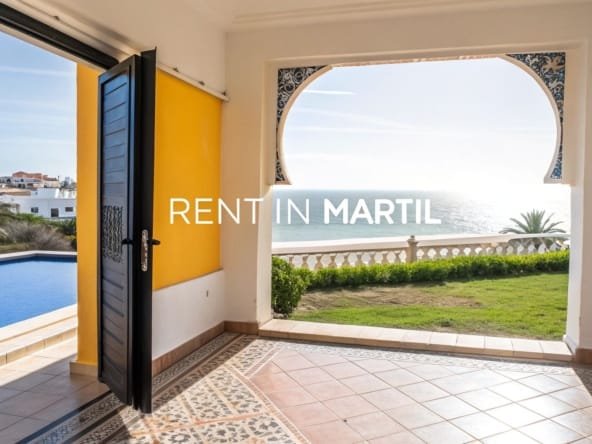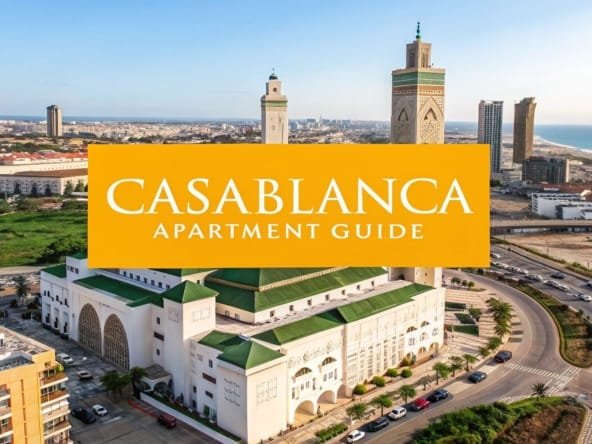Finding the right location for a riad in Marrakech isn't just about picking a beautiful property; it's about choosing a neighbourhood that truly fits your lifestyle. Marrakech is a city of captivating contrasts. On one hand, you have the ancient, labyrinthine Medina teeming with authentic riads, and on the other, the modern, cosmopolitan districts of Gueliz and Hivernage with their contemporary comforts.
Your entire experience of living in Marrakech will hinge on which of these vibrant settings you decide to call home.
Choosing the Right Marrakech Neighbourhood
Where you choose to live is the most critical decision you'll make when renting a riad. It’s a classic trade-off: do you want total historical immersion or modern convenience? Each part of the city beats to a completely different rhythm.
A riad is far more than a house; it’s a private sanctuary built around a central courtyard, a design concept steeped in Moroccan history and culture. These traditional homes are engineered for privacy and peace, with their inward-facing architecture offering a cool respite from the city's heat. This design, which often includes a central fountain and garden, has evolved since the 12th century and was perfected by wealthy families seeking a tranquil urban escape.
The Medina: The Heart of Authenticity
To live in the Medina is to immerse yourself completely in the spirit of Marrakech. Your daily life unfolds amidst a maze of winding alleyways (derbs), the vibrant chaos of the souks, and the constant hum of artisans plying their trades. A riad here is a genuine retreat—a quiet, serene courtyard hidden away from the electric energy just outside your door.
Of course, this authentic lifestyle has its practical considerations. Much of the Medina is a pedestrian-only zone. That means you'll be carrying your groceries home through narrow lanes, and depending on your proximity to major squares like Jemaa el-Fna, the noise can be intense. But for anyone craving a truly unfiltered Moroccan experience, nothing compares to the Medina.
Key Takeaway: Renting in the Medina is for those who prioritise cultural immersion and are ready to embrace a car-free, often bustling, but incredibly rewarding lifestyle. It’s an experience, not just a place to live.
Gueliz and Hivernage: Modern Comforts
In stark contrast, neighbourhoods like Gueliz and Hivernage showcase Marrakech's modern side. Here, you'll find wide, tree-lined avenues, sleek apartment buildings, international shops, and a sophisticated cafe culture.
While you might find modern homes with riad-inspired touches, authentic, traditional riads are much less common. Life here is undeniably more convenient. You have easy access for your car, large supermarkets are just around the corner, and the overall feel is more familiar to anyone used to city living. This makes it a popular choice for expats looking for a gentler transition into Moroccan life. For more on this, our guide on the top neighbourhoods to buy your perfect home in Marrakech has some great insights that are just as relevant for renters.
The chart below gives you a clear idea of how monthly rents stack up across these distinct areas.
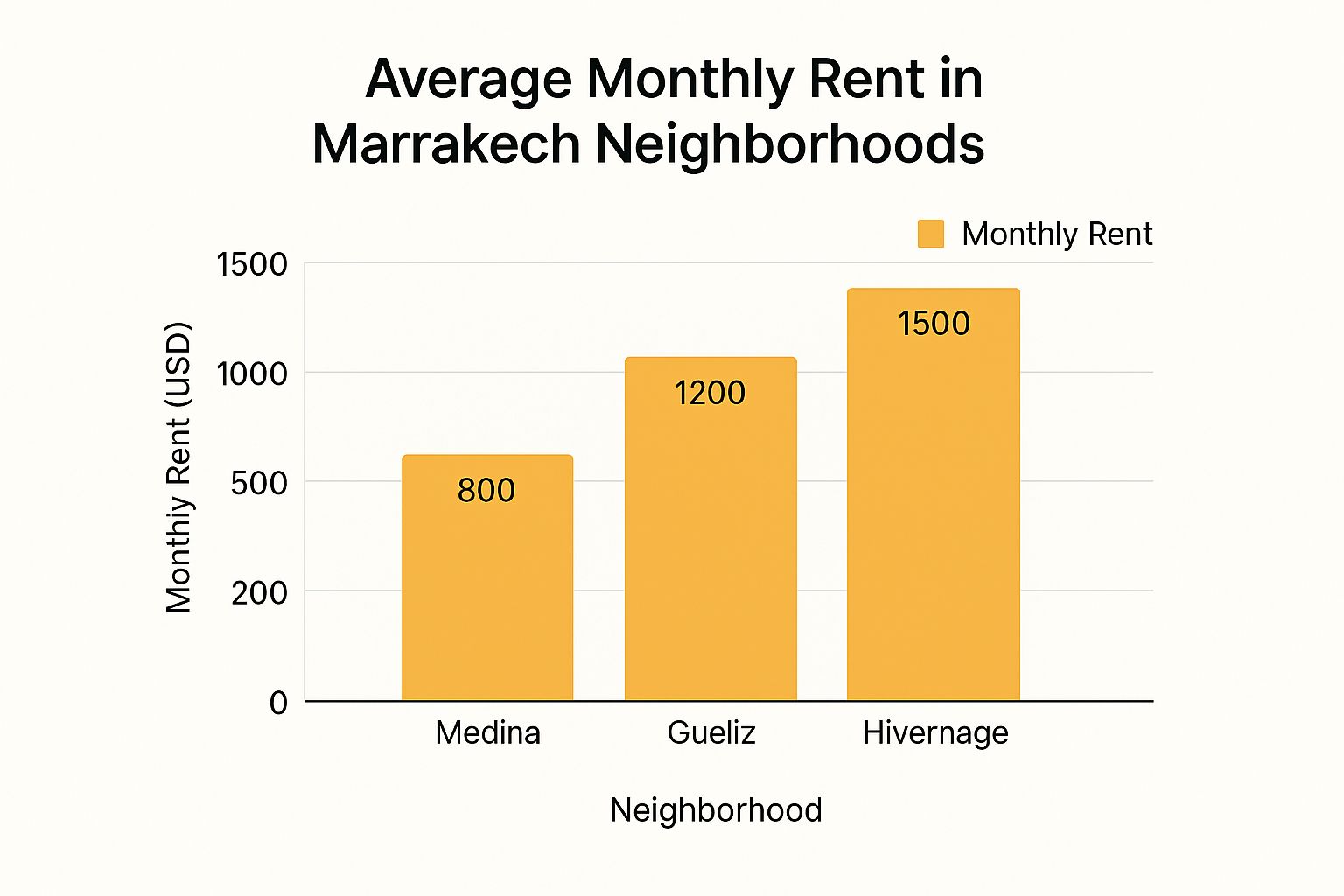
As the numbers show, the modern amenities and convenience of Gueliz and Hivernage generally command a higher price compared to the more traditional options within the Medina.
To help you weigh your options, here’s a quick breakdown of what each neighbourhood has to offer.
Comparing Top Marrakech Neighborhoods for Riad Rentals
This table provides a comparative overview of the most popular neighbourhoods in Marrakech for riad rentals, helping you choose the best fit for your lifestyle and preferences.
| Neighbourhood | Best For | Average Rental Price (Monthly) | Pros | Cons |
|---|---|---|---|---|
| The Medina | Cultural immersion, authentic lifestyle, walkability | MAD 12,000 | Historic charm, close to souks and major sights, strong sense of community | Pedestrian-only access, can be noisy, less modern infrastructure |
| Gueliz | Modern convenience, shopping, nightlife | MAD 18,000 | Easy car access, international restaurants and shops, modern amenities | Lacks traditional charm, higher cost of living, traffic congestion |
| Hivernage | Luxury living, quiet residential feel, upscale entertainment | MAD 22,000 | High-end properties, proximity to luxury hotels and casinos, well-maintained | Most expensive area, fewer traditional riads, less authentic cultural feel |
| Kasbah | A quieter, more local Medina experience | MAD 14,000 | Authentic but less touristy, near royal palaces, more residential | Still has access challenges, fewer dining options than central Medina |
| Sidi Ghanem | Artists, designers, and creative professionals | MAD 16,000 | Industrial-chic vibe, showrooms and workshops, growing community | Located outside the city centre, requires a car, primarily industrial |
Ultimately, your choice depends on what you value most. Are you looking for a historic adventure or a comfortable, modern base from which to explore the city? Answering that question is the first step toward finding your perfect riad.
Mastering Your Riad Search and Viewings
Now that you've pinpointed your ideal neighbourhood, the real fun begins: the hunt for your perfect Marrakech riad. Finding a place here is often a mix of modern online searches and old-school, on-the-ground networking. It's just how the city works.
You can certainly start your search on online portals like Mubawab, Sarouty.ma, or even the general classifieds site Avito.ma. These are great for getting a feel for the market, seeing what's available, and understanding the general price points for different areas. It’s a solid first step you can take from anywhere.
But here’s a crucial local tip: many of the most incredible riads are never advertised online. They change hands through word-of-mouth, often via local agents known as semsars. These individuals are incredibly well-connected and are the gatekeepers to a hidden market of unlisted gems.
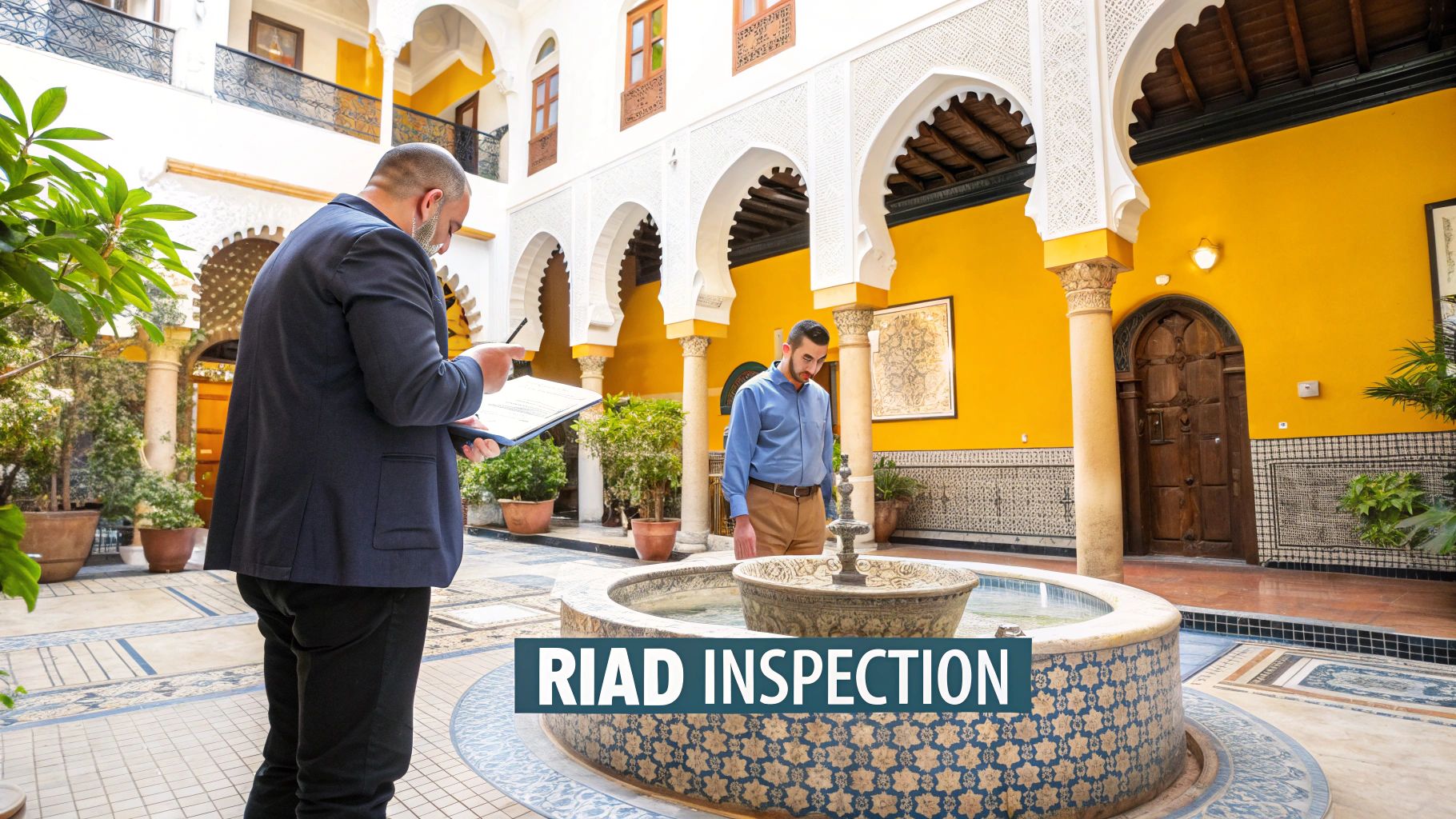
The Riad Viewing Checklist
Once you start lining up viewings, it's time to put on your detective hat. The pictures online might be gorgeous, but nothing beats an in-person visit to uncover the reality of a place. You need to look past the beautiful zellige tiles and the tranquil courtyard to see the bones of the home.
The small, practical details are what will shape your day-to-day life. Getting these right is the difference between a dream home and a constant source of frustration.
- Look for Damp: Scan the walls, especially on the ground floor and in bathrooms, for any hint of water damage, mould, or peeling paint. Damp can be a real headache in older, traditional homes.
- Test Everything: Don't be shy. Turn on the taps to check the water pressure. Flush the toilets. Flick the light switches on and off. If the riad is furnished, ask to test the air conditioning and heating. You'll be grateful you did when you're facing the extremes of a Marrakech summer or winter.
- Gauge the Natural Light: How is the riad oriented? A courtyard bathed in sunlight feels warm and inviting. One that's stuck in the shade all day can feel dark and chilly, especially in the winter.
- Just Listen: Stand still for a minute and pay attention to the sounds from the derb (alleyway) outside. Can you hear a noisy workshop? Are you on a busy thoroughfare for motorbikes? If you can, try to visit at different times of the day to get a true sense of the noise levels.
A riad might look stunning, but if it has terrible water pressure and is next to a noisy alley, the charm will wear off very quickly. Your viewing is the best chance to spot these potential deal-breakers before you've signed anything.
Working with a Semsar
Bringing a semsar into your search can be a game-changer. They can open doors to properties you'd never find otherwise. The key is knowing how they work. Typically, their commission is paid by the landlord, so their service should be free for you as the renter.
The more specific you are with a semsar, the better. Tell them exactly what you need: your preferred neighbourhood, the number of rooms, your firm budget, and any non-negotiables. A good semsar respects your time and will only show you places that tick the right boxes. Building a solid relationship with one can lead you straight to that hidden gem you've been looking for.
If you'd prefer to start with a more curated selection, browsing verified listings for a riad for rent in Marrakech can provide a great benchmark for quality and pricing as you begin your search.
Getting to Grips with Budgets and Contracts
Finding the perfect riad in Marrakech is thrilling, but the real work begins when you start talking numbers and paperwork. Before you get lost in dreams of sipping mint tea in a sun-drenched courtyard, it’s essential to get a firm handle on your finances and the legal agreement that will be your safety net.
The advertised monthly rent is really just your starting point. To avoid any nasty surprises later on, you need to budget for several other key costs that come with renting in Morocco.
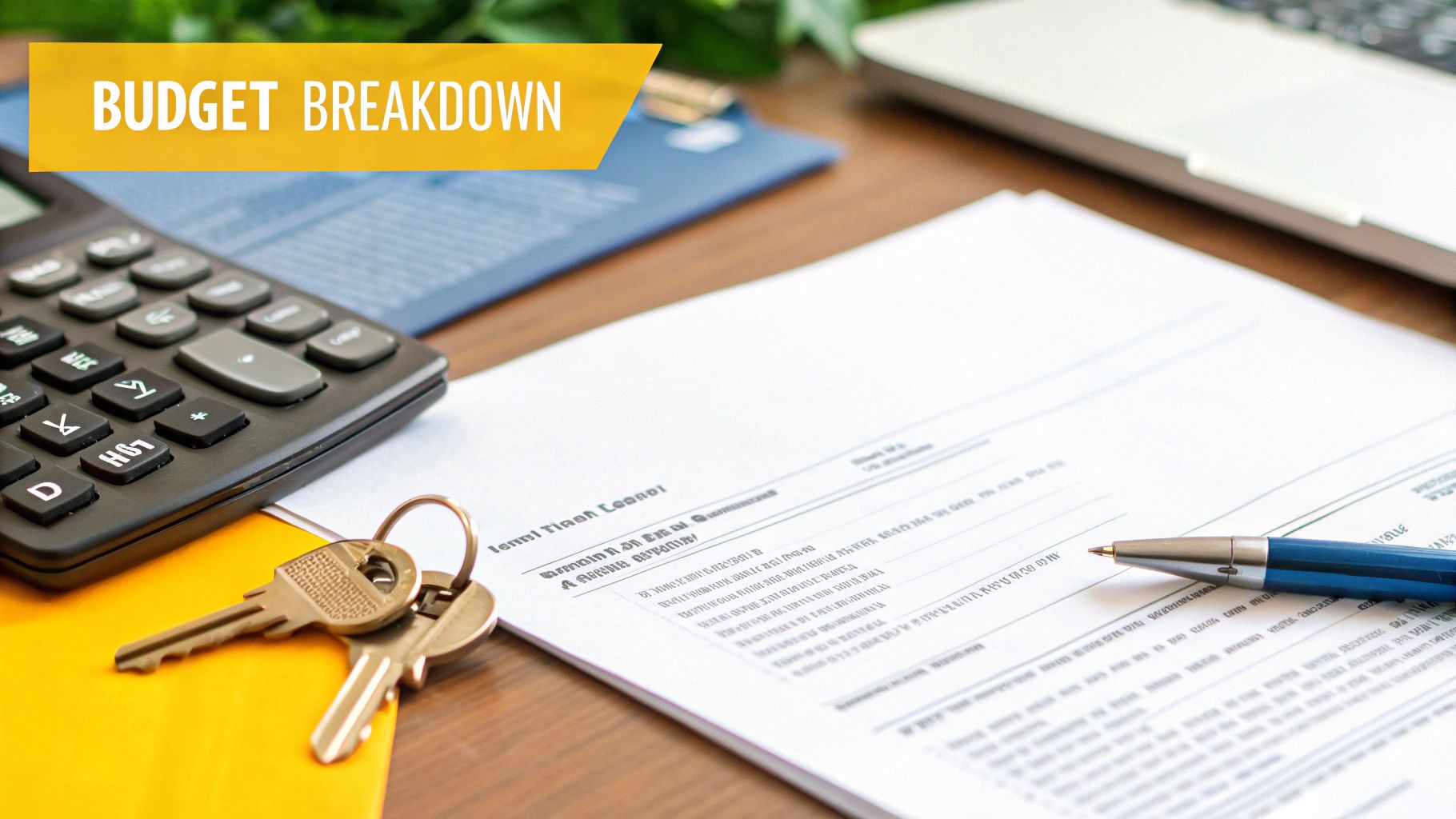
Looking Beyond the Monthly Rent
First up is the security deposit, or caution as it's called locally. The standard practice is to ask for the equivalent of two months' rent. This is a significant sum you'll need to have ready to go, along with your first month's payment, right at the beginning.
Did you use an agency or a local agent (semsar)? If so, you'll have their fee to consider. This is almost always a one-off payment equal to one month's rent, which you’ll pay once you sign the lease.
And don't forget the utilities. Long-term rentals rarely include bills for electricity, water, or internet. You'll be setting these up in your own name, so it’s smart to set aside an extra 1,000 to 1,500 MAD each month to cover these variable costs.
Making Sense of the Moroccan Rental Contract
The contrat de bail is the legal heart of your rental agreement. This document is your single most important form of protection, so never, ever agree to rent a place without a clear, written contract. It lays out what's expected of you and what you can expect from your landlord.
Crucial Insight: Always demand a formal, written contrat de bail that is legally registered. A simple handshake deal or a verbal promise gives you absolutely no legal standing and puts you at risk of losing your deposit or facing unfair eviction.
Your contract will be in either French or Arabic. If you aren’t fluent in the language, it's well worth the peace of mind to have a trusted translator go over it with you line by line before you sign anything.
There are a few clauses you need to pay extra close attention to:
- Lease Duration (Durée du Bail): Most long-term rental contracts in Morocco run for at least one year. Make sure you understand the initial term and the conditions for renewing the lease down the road.
- Maintenance Responsibilities (Entretien et Réparations): The agreement should spell out who pays for what. Usually, tenants are responsible for small, day-to-day upkeep, while landlords cover major structural repairs.
- Notice Period (Préavis): This part tells you how much notice you need to give before you can move out, which is typically between one and three months. Knowing this is key to getting your full security deposit back without any hassle.
To get a more thorough understanding of the legal side, it's a good idea to learn more about the contrat de bail in Morocco before you commit. Nailing down these details from the start is the best way to ensure your time in Marrakech is as smooth and conflict-free as possible.
Sealing the Deal: How to Negotiate and Secure Your Riad
So, you’ve found a promising location riad marrakech that feels like it could be home. Now comes the final, and perhaps most quintessentially Moroccan, part of the journey: the negotiation. In Marrakech, haggling over the price isn't seen as confrontational; it's a completely normal, expected part of any big transaction. The price you see advertised is almost always just an opening bid.
Your best asset here is solid information. Before you even think about making an offer, do your homework. Look up what similar riads in that same neighbourhood are going for. If the place you've fallen for is listed at 15,000 MAD, but you see comparable properties renting for closer to 12,000 MAD, you have a strong, respectful foundation to propose a lower price. You can gently point to specific things—maybe the condition of the kitchen or the absence of an air conditioning unit—to back up your offer.
The Art of the Deal
When you make your first offer, a good starting point is usually about 15-20% below the asking price. This signals that you're a serious potential tenant, not a time-waster, but it also leaves plenty of space for the landlord to come back with a counteroffer. Think of it as a conversation, a bit of a dance. Your patience and friendly demeanour are just as critical as the numbers you're discussing.
Remember, it's not just about the monthly rent. You can negotiate on a lot of other things. Is the riad unfurnished? You could try asking the landlord to throw in key appliances like a fridge or a washing machine. For a shorter-term rental, perhaps you can get the utility bills included. You could even request a fresh coat of paint before moving in.
The real aim here isn't to "win" the negotiation. It's to find a middle ground where both you and the landlord feel you've struck a fair deal. Kicking things off on a positive note is a fantastic way to build a good relationship from the very beginning.
Getting the Paperwork in Order
Once you’ve shaken hands on the terms, it's time to put it all in writing. The landlord or their agent will need a few documents from you to draw up the formal rental contract, the contrat de bail. This part is usually quite straightforward, as long as you have your documents ready.
You will almost certainly be asked for:
- A clear copy of your passport.
- Proof of your legal status in Morocco, like a visa or your residency permit (carte de séjour).
- Evidence that you can afford the rent, which could be anything from a letter from your employer to recent bank statements.
This isn't just bureaucracy; this paperwork protects both of you and is standard practice for any official rental agreement in Morocco.
This tradition of grand homes and formal agreements is stitched into the very history of the city. As an imperial capital, especially under the Saadian dynasty in the 16th century, Marrakech saw the rise of stunning palaces and riads that became the heart of family and social life. You can learn more about how Marrakech’s history shaped its unique architecture to understand the context.
With the documents handed over, the last hurdle is paying the security deposit and the first month's rent. Make sure you walk away with a signed contract in one hand and a receipt for your payment in the other. Once that’s done, the keys are yours. Welcome to your new life in Marrakech
Your Move-In and Settling In Checklist
You've signed the contract and the keys are finally in your hand. The search for the perfect location riad marrakech is over, but the adventure is just beginning. Now it's time to transform this beautiful space into your own personal sanctuary. A smooth move-in sets the tone for your entire stay and, crucially, protects your deposit.
The very first thing you need to do, before a single box is unpacked, is the état des lieux. This is the official inventory and condition report, and you absolutely must do it with your landlord or their agent present. Think of it as a meticulous, room-by-room inspection where you document the exact state of the riad.
Don't let anyone rush you through this. It might feel tedious, but this document is your single most important piece of evidence if any disagreements about damages pop up when you eventually move out.
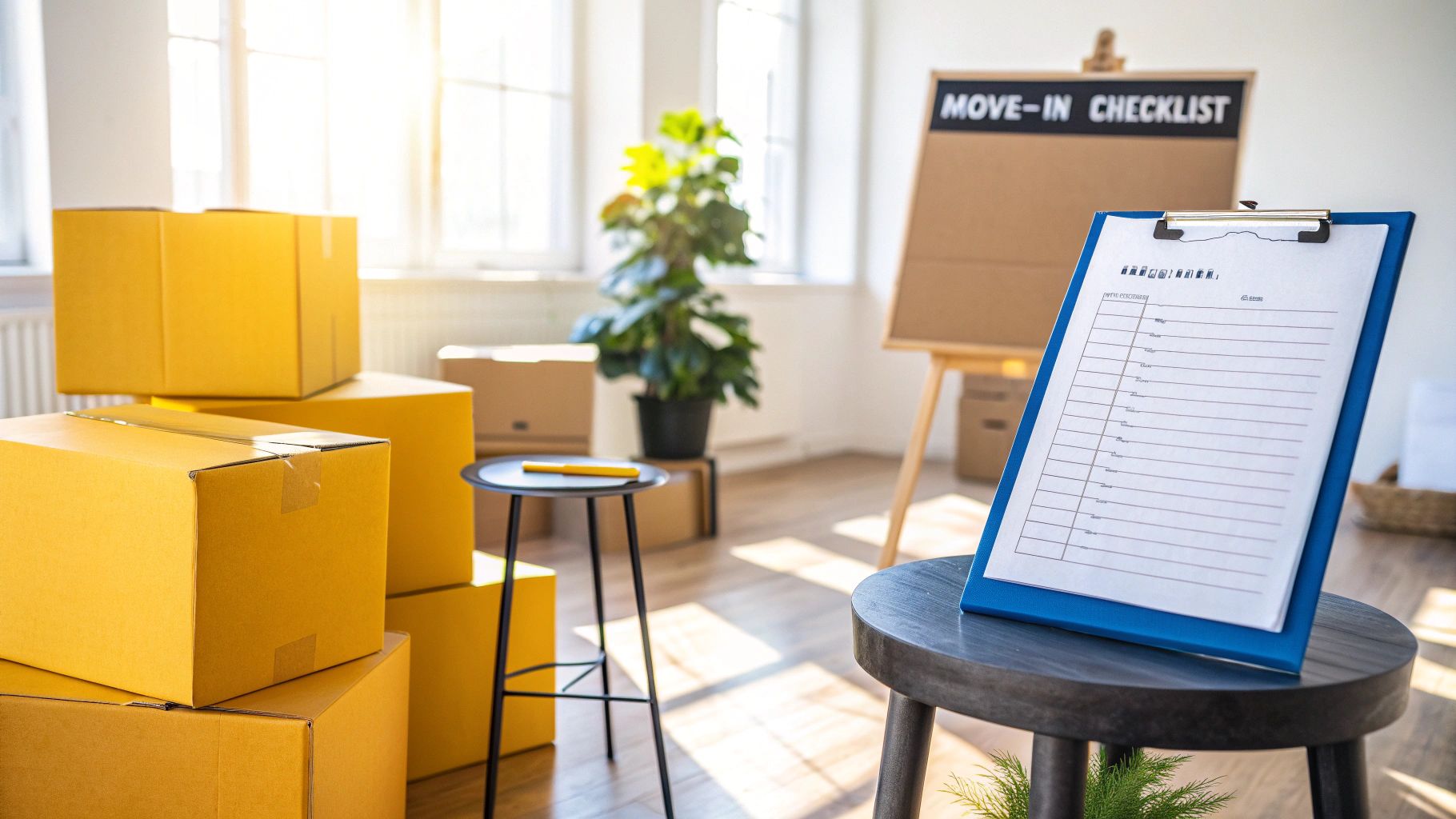
Document Everything Meticulously
Your smartphone is your best friend during the état des lieux. Go through the entire riad and take clear, well-lit photos and videos of everything. Pay special attention to any existing wear and tear, no matter how minor it seems.
- Scuffs and Scratches: Get close-ups of any marks on the walls, floors, doors, or furniture.
- Cracks or Stains: Note any chips in the zellige tiles, water marks on the tadelakt walls, or stains on cushions.
- Appliance Functionality: Take a quick video of you turning on the air conditioning, testing the kitchen appliances, and checking the hot water. This proves they were working from day one.
Once you're done, organise these files and pop them in an email to your landlord. This creates an indisputable, time-stamped record that you both agreed on the riad's condition before you moved in.
Pro Tip: It’s the little things that often cause the biggest headaches later. That tiny chip in a teacup or a small scratch on a side table might seem trivial now, but documenting it could save you a chunk of your deposit down the road.
Getting Set Up and Embracing the Community
With the paperwork squared away, you can start making the riad feel like home. Getting your utilities connected is the next step. If you're on a long-term lease, you'll likely need to register for water and electricity in your own name. Your landlord should be able to walk you through the process. For internet, companies like Maroc Telecom or Orange are the usual go-tos, and getting connected is generally quite simple.
Finally, remember that life in the medina happens in the derb (alleyway). This is a community, and one of the most important people you'll meet is the local gardien. This is the neighbourhood guardian who looks after security and helps keep the alley tidy.
Make a point of introducing yourself as soon as you can. Your gardien will become an invaluable resource, helping with everything from finding a parking spot to taking in a delivery when you're out. Building a good rapport with them and your neighbours is the quickest way to truly settle in and feel at home in your new Marrakech haven.
A Few Last-Minute Questions Answered
Even after you've found the perfect riad and are ready to sign, a few nagging questions can pop up. It happens to everyone. Let's run through some of the most common queries we get from clients, so you can handle these final steps like a seasoned pro.
Think of this as your quick-reference guide for those final "what if" moments. Getting these details right is the key to a smooth, stress-free start to your new life in Marrakech.
Do I Really Need a Moroccan Bank Account?
For a short holiday let, you can probably get by without one. But if you're planning a long-term stay, a Moroccan bank account is practically essential. Most landlords strongly prefer receiving monthly rent via a simple bank transfer—it's just easier and more secure for everyone.
Beyond rent, having a local account makes daily life so much simpler. You’ll use it to pay for water and electricity, set up an internet connection, and handle everyday transactions without a hitch. To get started, you'll typically need your passport, your new rental contract as proof of address, and your residency permit or long-stay visa.
What If I Have to End My Lease Early?
Life is full of surprises, and sometimes you have to move on sooner than expected. If you need to break your lease, your first port of call should be the rental agreement itself, the contrat de bail. Look for the termination clause, which will specify the required notice period, known as the préavis.
The standard notice period is usually between one and three months. It's absolutely vital that you give this notice to your landlord in writing. Cutting corners here could mean losing your entire security deposit, so clear and formal communication is your best friend.
Are Utilities Included in the Rent?
For long-term riad rentals, the answer is almost always no. You'll be responsible for your own electricity, water, and internet bills. This actually works in your favour, as it gives you complete control over how much you use and which internet provider you choose.
It's a different story for short-term holiday lets, where utilities are often bundled into the price for simplicity. Just be sure to confirm this in your agreement so there are no surprises down the line.
How Safe Is It to Live in a Medina Riad?
Absolutely. Living in a Medina riad is a wonderful experience enjoyed by countless Moroccans and expats, and it’s generally very safe. The very nature of the Medina, with its maze of narrow alleyways (derbs), creates close-knit communities where everyone knows their neighbours and people look out for each other.
Many derbs also have their own guardians, or gardiens, who keep an eye on things and provide an extra layer of security. Of course, just like in any major city, it pays to be aware of your surroundings, especially when walking through quieter lanes late at night.
The unique charm of riad living is a huge draw for visitors. By May 2023, occupancy rates in Marrakech's hotels and riads hit 73%—a huge increase from pre-pandemic figures. Many of these visitors are specifically looking for that authentic heritage experience that only a riad can offer. You can read more about the enchanting world of riads on mymarrakechtours.com.
At Rich Lion Properties, we're here to guide you through every step of your Moroccan property journey. Whether you're renting your first riad or looking to invest, our team has the local expertise you need. See how we can help at https://richlionproperties.com.

